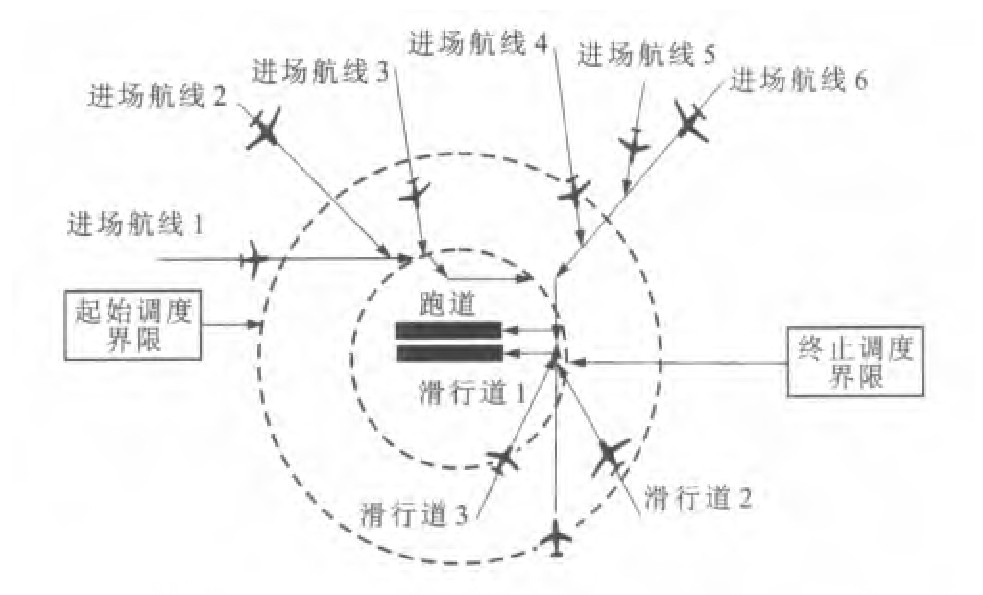Optimization algorithm of flight takeoff and landing on multi-runways
-
摘要: 为了提升大型繁忙机场的运行效率, 考虑了多跑道的运行条件和安全要求等因素, 以最小航班总延误为目标函数, 以最大位置偏移为约束条件, 引入滚动时域控制策略, 建立了航班动态排序模型。针对多跑道航班调度问题的特点, 分别采用基于滚动时域控制策略的遗传算法和现有的先到先服务算法求解模型。计算结果表明: 当航班正常时, 采用现有的先到先服务算法, 航班总延误为1 712s, 采用基于滚动时域控制策略的遗传算法, 航班总延误为1 080s, 与先到先服务算法相比, 延误时间减小37.0%;当航班不正常时, 采用现有的先到先服务算法, 航班总延误为1 658s, 采用基于滚动时域控制策略的遗传算法, 航班总延误为969s, 与先到先服务算法相比, 延误减小41.5%。可见, 基于滚动时域控制策略的遗传算法有效。Abstract: In order to improve the operation performance of large busy airport, some factors of multi-runways such as operation condition and safety requirement were considered. The minimum total flight delay was taken as objective function, the maximum position shift was taken as constraint condition, receding horizon control(RHC) strategy was introduced, and the dynamic flight sequencing model was established. Aiming at the characteristics of flight scheduling problem for multi-runways, the model was solved by using the genetic algorithm based on RHC strategy(RHC-GA) and the existing first come first serve(FCFS) algorithm respectively. Calculation result shows that when flights are normal, the total flight delay is 1 712 s by using FCFS algorithm. The total flight delay is 1 080 s by using RHC-GA, and reduces by 37.0% compared with the result of FCFS algorithm. When flights are not normal, the total flight delay is 1 658 s by using FCFS algorithm. The total flight delay is 969 s by using RHC-GA, and reduces by 41.5% compared with the result of FCFS algorithm. So RHC-GA is effective.
-
Key words:
- air transportation /
- traffic flow management /
- flight sequencing /
- RHC strategy /
- genetic algorithm /
- chromosome coding
-
表 1 最小时间间隔
Table 1. Minimum time intervals

表 2 航班正常时的计算结果
Table 2. Calculation result when flights are normal

表 3 航班不正常时的计算结果
Table 3. Calculation result when flights are not normal

-
[1] LAMBRECHT M, SLATER G L. Departure trajectory mod-eling for air traffic control automation tools[C]∥AIAA. Pro-ceedings of AIAA Guidance, Navigation, and Control Con-ference and Exhibit. Portland: AIAA, 1999: 1507-1520. [2] BOLENDER M A, SLATER G L. Cost analysis of the departure-en route merge problem[J]. Journal of Aircraft, 2000, 37(1): 23-29. doi: 10.2514/2.2585 [3] ANDERSSON K, HALL W, ATKINS S, et al. Optimization-based analysis of collaborative airport arrival planning[J]. Transportation Science, 2003, 37(4): 422-433. doi: 10.1287/trsc.37.4.422.23274 [4] SARAF A P, SLATER G L. An efficient combinatorial opti-mization algorithm for optimal scheduling of aircraft arrivals at congested airports[C]∥IEEE. Proceedings of Aerospace Conference. Helena: IEEE, 2006: 11-22. [5] LEE H, BALAKRISHNAN H. Fuel cost, delay and throughput tradeoffs in runway scheduling[C]∥IEEE. Pro-ceedings of American Control Conference. Washington DC: IEEE, 2008: 2449-2454. [6] 周茜, 张学军, 柳重堪. CDM GDP程序中混合使用跑道时隙分配问题研究[J]. 空中交通管理, 2005, 5(1): 23-26. https://cdmd.cnki.com.cn/Article/CDMD-10004-1015594142.htmZHOU Qian, ZHANG Xue-jun, LIU Zhong-kan. Study on time slot allocation for mixed runway application in CDM GDP program[J]. Air Traffic Management, 2005, 5(1): 23-26. (in Chinese). https://cdmd.cnki.com.cn/Article/CDMD-10004-1015594142.htm [7] 程晓航, 薛惠锋, 洪鼎松, 等. 进港飞机调度的精华自适应遗传算法设计[J]. 交通与计算机, 2006, 24(6): 91-94. https://www.cnki.com.cn/Article/CJFDTOTAL-JTJS200606025.htmCHENG Xiao-hang, XUE Hui-feng, HONG Ding-song, et al. Design of elitist adaptive genetic algorithm in arrival aircraftsscheduling[J]. Computer and Communications, 2006, 24(6): 91-94. (in Chinese). https://www.cnki.com.cn/Article/CJFDTOTAL-JTJS200606025.htm [8] 孙宏, 张翔, 徐杰. 应用模拟退火算法求解飞机调度问题[J]. 飞行力学, 2006, 24(4): 84-87. https://www.cnki.com.cn/Article/CJFDTOTAL-FHLX200604021.htmSUN Hong, ZHANG Xiang, XU Jie. Applying the simulated annealing algorithm to solve airliner aircraft dispatching prob-lem[J]. Flight Dynamics, 2006, 24(4): 84-87. (in Chinese). https://www.cnki.com.cn/Article/CJFDTOTAL-FHLX200604021.htm [9] 王海东, 孙淑光, 华克强. 模糊Petri网在飞机进近排序中的应用[J]. 系统仿真学报, 2007, 19(18): 4298-4301. doi: 10.3969/j.issn.1004-731X.2007.18.048WANG Hai-dong, SUN Shu-guang, HUA Ke-qiang. Appli-cations of fuzzy Petri net method in aircraft approach sequen-cing[J]. Journal of System Simulation, 2007, 19(18): 4298-4301. (in Chinese). doi: 10.3969/j.issn.1004-731X.2007.18.048 [10] 李志荣, 张兆宁. 基于蚁群算法的航班着陆排序[J]. 交通运输工程与信息学报, 2006, 4(2): 66-69. https://www.cnki.com.cn/Article/CJFDTOTAL-JTGC200602013.htmLI Zhi-rong, ZHANG Zhao-ning. Prioritizing landing flights based on ACS[J]. Journal of Transportation Engineering and Information, 2006, 4(2): 66-69. (in Chinese). https://www.cnki.com.cn/Article/CJFDTOTAL-JTGC200602013.htm [11] 张洪海, 胡明华. 多跑道着陆飞机协同调度多目标优化[J]. 西南交通大学学报, 2009, 44(3): 402-409. doi: 10.3969/j.issn.0258-2724.2009.03.017ZHANG Hong-hai, HU Ming-hua. Multi-objection optimiza-tion for collaborative scheduling aircraft landing on multi-run-ways[J]. Journal of Southwest Jiaotong University, 2009, 44(3): 402-409. (in Chinese). doi: 10.3969/j.issn.0258-2724.2009.03.017 [12] 曹力, 邓雪云, 王旭辉, 等. 基于机型间隔的机场终端区流量优化[J]. 系统工程学报, 2009, 24(3): 360-364. https://www.cnki.com.cn/Article/CJFDTOTAL-XTGC200903017.htmCAO Li, DENG Xue-yun, WANG Xu-hui, et al. Airport ter-minal area flow optimization based on aircraft traffic gaps[J]. Journal of Systems Engineering, 2009, 24(3): 360-364. (in Chinese). https://www.cnki.com.cn/Article/CJFDTOTAL-XTGC200903017.htm [13] HU Xiao-bing, CHEN Wen-hua. Receding horizon control for aircraft arrival sequencing and scheduling[J]. IEEE Transactions on Intelligent Transportation System, 2005, 6(2): 189-197. [14] 杨晶妹. 终端区进场航班排序方法研究[D]. 南京: 南京航空航天大学, 2010.YANG Jing-mei. Research on algorithms for scheduling arrival aircrafts in terminal area[D]. Nanjing: Nanjing University of Aeronautics and Astronautics, 2010. (in Chinese). [15] 施赛锋. 广州终端区进离场航班排序系统研究[D]. 南京: 南京航空航天大学, 2011.SHI Sai-feng. The research on terminal aircraft sorting sys-tem in Guangzhou[D]. Nanjing: Nanjing University of Aero-nautics and Astronautics, 2011. (in Chinese). [16] 韩云祥, 汤新民, 韩松臣. 固定航路最优飞行冲突解脱模型[J]. 交通运输工程学报, 2012, 12(1): 115-120. http://transport.chd.edu.cn/article/id/201201018HAN Yun-xiang, TANG Xin-min, HAN Song-chen. Con-flict resolution model of optimal flight for fixation airway[J]. Journal of Traffic and Transportation Engineering, 2012, 12(1): 115-120. (in Chinese). http://transport.chd.edu.cn/article/id/201201018 -





 下载:
下载:



